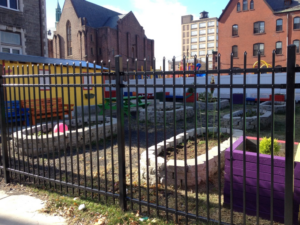Connecting with Nature in a Concrete Jungle

Connecting with Nature in a Concrete Jungle
“There’s a tree that grows in Brooklyn… It grows in boarded-up lots and out of neglected rubbish heaps. It grows up out of cellar gratings. It is the only tree that grows out of cement. It grows lushly… survives without sun, water, and seemingly without earth” (Smith 1943).

Out-of-school time educators who work in urban settings may feel like they have few to no options for connecting youth to nature. Where is nature in a concrete jungle? But Smith reminds all of humanity that even in the toughest urban settings, the natural world breaks through. It is the educator’s job to notice nature and to provide opportunities for children to observe and be curious about it. Likewise, it is the provider’s role to introduce nature to a setting when it is absent.
Finding Nature
Is your “outdoor space” a fenced parking lot? Take time to look at the sky. Notice the clouds, sun, shadows, wind, rain, and snow. Hang a large numbered thermometer, windsock, or wind chimes to more easily draw attention to the weather. Have a small box of nylon colored streamers that kids can run with or hold in the wind.
In Chicago, there are forest preserves. In Philadelphia, Fairmount Park. But it doesn’t need to be these vast, formal places where children discover nature in an urban setting. Look for birdhouses in the trees, a community garden in a pocket park. Visit a library or corporate space that has an atrium.


This cool Globe in Pittsburgh, part of an international climate change awareness project, celebrates the positive impact that urban trees and urban greenery have on a city’s (and a planet’s) health. According to the description, city trees cover 40% of Pittsburgh’s land area and are vital to parks, green spaces, and quality of life.
On a neighborhood walk, collect sticks and create art with them once children have returned to the classroom. Notice weeds pushing through cracks in the sidewalk or a tree in blossom. Allow the children to crack open nuts or seed pods and investigate the contents with a magnifier.
Plan a “nature” field trip. Invite some family volunteers to join a classroom group. Take a water jug, cups, blankets, and some paper bags to gather interesting nature items. Walk to a pocket park or community garden. Sit under a tree and read a book together or look at the grass with magnifiers. In anticipation of such a field trip, staff or a director should check the space earlier in the day to make sure the area is free of urban debris and safe to explore.
Nurturing Nature
If the environment outside a center’s fence is not safe, find ways to nurture nature inside the walls of the center or school. Hang a birdhouse on a fence post or tree. Plant a garden. Fill an old tire with a layer of old stones and top with a thick layer of potting soil. Drive a stake into the center of this raised garden bed and plant pole beans. Planting herbs like mint, parsley, or cilantro is a child safe option, too. Add stumps or other natural materials to your play yard. Sometimes the city public works department can help locate stumps and deliver them to your location. Can a community volunteer help the children build a worm garden? Or set up a composter? These are all realistic ways to explore nature in an urban setting. If your space is secure, considering adding a “water feature.” A commercially made fountain or water wall is not exactly “natural” but it does add the sound, sight, and feel of running water which is very relaxing for people of all ages. Be sure to check with licensing about any applicable rules before investing in this area.

References
“Cool Globes: Hot Ideas for a Cooler Planet.” http://www.coolglobes.org/
Smith, Betty. 1943. A Tree Grows in Booklyn. Harper & Row.
